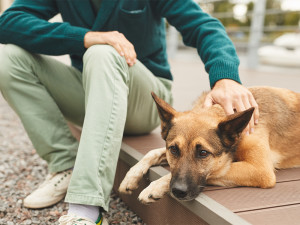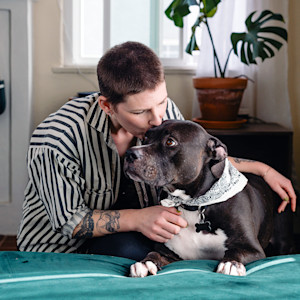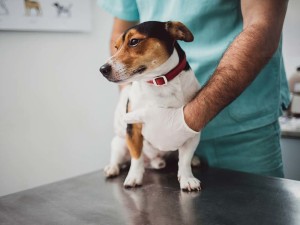What Can I Give My Dog for Constipation?
Help them get some relief.

Share Article
In This Article:
What Is Constipation in Dogs? opens in a new tab Why Is My Dog Constipated?opens in a new tab Dog Constipation Symptomsopens in a new tab At-Home Treatments for Dog Constipationopens in a new tab Veterinary Treatment Options for Dog Constipationopens in a new tab Frequently Asked Questionsopens in a new tab
I spend a lot of time at work talking about poop. Diarrhea, most commonly. But occasionally, dogs experience the opposite problem, specifically dogs who can’t poop. Although this isn’t as common as dogs experiencing diarrhea, especially in my neck of the woods (lots of mystery food or non-food items on the sidewalks in New York City!), a dog experiencing constipation is distressful to both them and you.
Fortunately, there are several safe and effective remedies for constipation that you can try at home to help alleviate your dog’s discomfort.
What is constipation in dogs?
Constipation is difficulty passing poop or reduced frequency of bowel movements. You may notice your dog is posturing to poop with no actual production of poop or vocalizing when trying to defecate. When they do eventually poop, you may notice the stools appear dark, dry and harder than normal, or may occasionally have spots of blood.
All of theses observations are important when visiting with your veterinarian, which should happen if any of these signs occur. Occasionally dogs may strain and appear constipated following episodes of diarrhea, but this is likely due to spasming of the colon that dogs can experience following episodes of diarrhea.
Why is my dog constipated?
Dietary factors
Dogs who do not get enough fiber in their diet may experience constipation. Alternatively, dogs that recently have episodes of indiscriminate eating may experience constipation.
Dehydration
Dogs who don’t drink enough water may experience constipation. Ensure your dog has access to fresh water at all times. You can even add water to their food to encourage more water intake, or spice it up by offering ice cubes (especially nice on a hot day), or adding a small amount of low sodium chicken or beef broth to their water to encourage those that don’t like to drink water.
Lack of exercise
Physical activity can stimulate the digestive system and improve bowel regularity. When dogs (and people) exercise, this can increase gut motility and blood flow to the intestines, which can regulate and improve digestive function. When dogs live sedentary lifestyles, this can result in lower intestinal motility and constipation.
Certain medications
Certain medications can result in slowing of the gut, resulting in less frequent bowel movements. This is particularly true with certain drugs used during anesthesia or opioid pain medications. Typically, as long as your dog is eating well and otherwise healthy, these poops will make their way out eventually.
Medical conditions
Certain conditions, such as hypothyroidism, can result in lower gastrointestinal motility and subsequent constipation. Additionally, pain can contribute to constipation. Pain can trigger your pet’s stress response, which can result in lower motility of the intestines. Additionally, certain conditions, such as arthritis, can result in difficulty squatting and posturing to defecate. So, though your dog may need to poo, it may be painful to do so. Consult with your veterinarian if you believe your dog is experiencing any of the above.
Dog constipation symptoms
Straining to defecate or posturing for an excessive period of time
Hard, dry, or smaller than normal stools
Decreased appetite
Vomiting
Lethargy
Vocalizing when defecating
At-home treatments for dog constipation
Some of these remedies can help with mild constipation. However, persistent or severe constipation for more than one or two days may indicate a more serious issue and should be evaluated by a vet.
Increase water intake.
Ensure your dog has access to fresh water at all times. You can even add water to their food to encourage more water intake, or spice it up by offering ice cubes (especially nice on a hot day), or adding a small amount of low sodium chicken or beef broth to their water to encourage those that don’t like to drink water.
Add fiber to the diet.
Fiber can help bulk up stools and make them easier to pass. Plain pumpkin is an excellent source of fiber and can be found in most grocery stores. Make sure pumpkin is the only ingredient - no pumpkin pie filling for the pups!
Encourage exercise.
Taking regular walks can help promote good gastrointestinal motility and more regular bowel movements.
Give them olive oil.
For most dogs, about ½ a teaspoon of olive oil per meal is enough to remedy mild, occasional constipation in dogs. It can help lubricate the digestive tract and allow for easier passage of stool.
Or give them pumpkin.
Pumpkin is a great source of fiber, and can be added to the food to promote more regular bowel movements. Be careful to only use one to two tablespoons, as too much fiber may actually contribute to constipation. Make sure that the only ingredient in canned products is pumpkin, as added sugar and spices found in pumpkin pie filling is not recommended for your dog.
Veterinary treatment options for dogs with constipation
Laxatives and stool softeners
In cases of more severe constipation, your vet may prescribe a laxative or a stool softener to allow for easier bowel movements.
What laxative is safe for a dog?
Miralax can be used in dogs for minor constipation. This can be purchased over-the-counter, and is flavorless and odorless. It is recommended to use no more than ¼ tsp mixed into the food twice a day, keeping in mind that some dogs may develop diarrhea. If this occurs, reduce the frequency or discontinue altogether.
Prescription medications
Some prescription medications may assist with severe constipation. Lactulose is a laxative used to treat constipation. It works by pulling water into the intestines, which softens the stool and promote bowel movements. Additionally, in cases of severe constipation, your vet may recommend an enema. This should only be done under the care of a vet, and not at home, as this may result in stress for your dog and side effects.
Fluid therapy
In dogs with severe dehydration and constipation, your vet may recommend a course of fluids, either subcutaneously (under the skin) or intravenously (IV) during a stay at the hospital. This will help correct dehydration, and can help with bowel movements.
FAQs (People also ask):
How to ease constipation in dogs?
Constipation is not encountered very frequently in dogs, but when it does occur, you can do several things at home to help. This includes encouraging water intake, regular exercise, and providing fiber to help facilitate passage of stools.
What laxative is safe for dogs?
There are not many safe human laxatives available for dogs. Miralax can be given safely, short-term in dogs. However, it is best to consult with your veterinarian before giving any new medication.

Dr. Gabrielle Fadl, DVM
After graduating from Kansas State University College of Veterinary Medicine, Dr. Fadl returned to the New York area to pursue a one-year rotating internship and has been working in general practice since. Dr. Fadl loves working in the pet space to foster the powerful human-animal bond. She hopes to continually learn and grow to practice the best quality medicine. Her motto is “Keep calm and try to take it as it comes.”
Related articles
![feeding black dog rice water to help relieve diarrhea]() opens in a new tab
opens in a new tabThe Facts of Poop: How to Treat Your Dog’s Diarrhea
Shudder. It happens to all of us.
- opens in a new tab
What Can I Give My Dog for Diarrhea?
It’s not fun for anyone.
![Woman kisses her black pit bull dog on the head.]() opens in a new tab
opens in a new tabWhat Can I Give My Dog for an Upset Stomach?
It stinks to see them uncomfortable. Here’s what you can do.
- opens in a new tab
Can You Give Dogs Imodium?
And what else you can give your dog for diarrhea.
![Veterinarian examining a dog]() opens in a new tab
opens in a new tabHGE in Dogs: Causes, Symptoms and Treatment
Certain symptoms could mean your dog is battling a potentially fatal condition called hemorrhagic gastroenteritis (HGE). Here’s everything you need to know.
![Cavalier King Charles spaniel puppy running in a garden]() opens in a new tab
opens in a new tabParvovirus: How to Identify and Treat Parvo Symptoms in Puppies
The potentially deadly virus can be prevented with one simple step.








